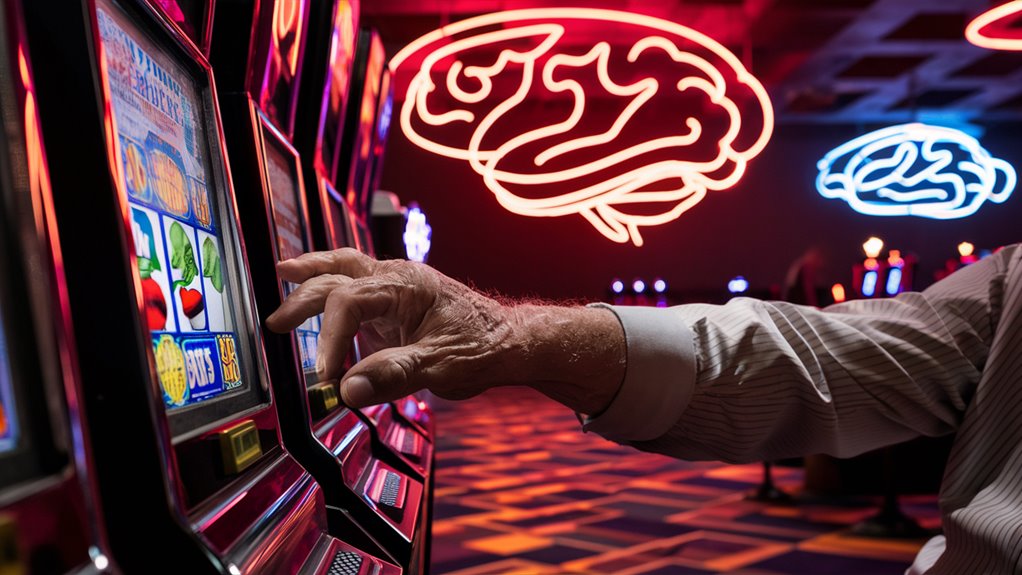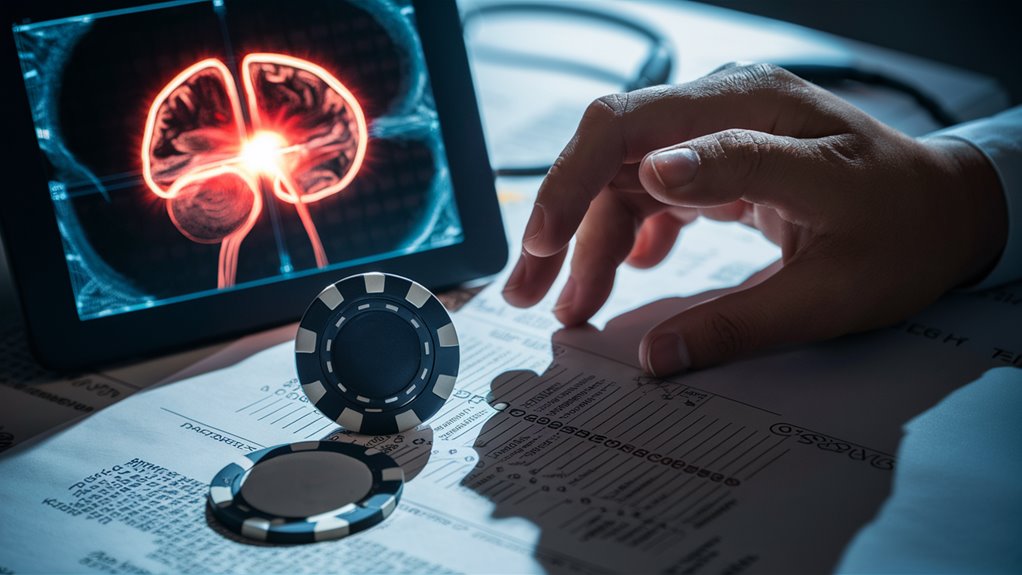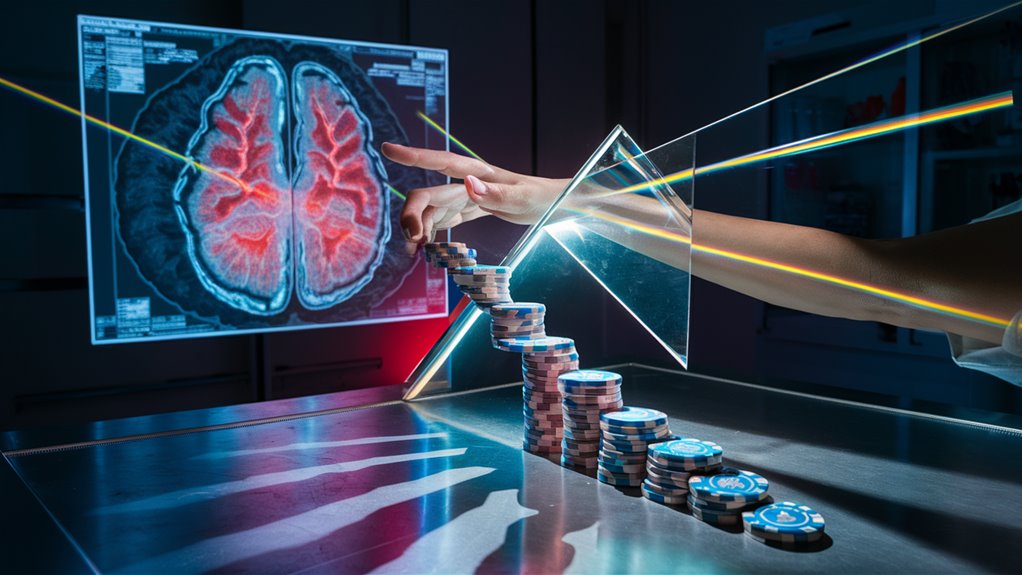
What You Must Know about Gambling Addiction: Brain Roads

How the Joy Drop, Dopamine, Spins Addiction
Gambling addiction messes with the brain’s joy roads by using dopamine, the key brain drop for fun and want. When one gambles, a win shoots big dopamine rushes acting like when we enjoy food or friends. This action fires up the ventral striatum and prefrontal cortex, setting up strong brain wires that make one want to gamble more. 먹튀검증커뮤니티 온카스터디
Modern Gambling Tech Changes the Brain
Slot machines and online bets grab your brain with bright lights and sounds to boost dopamine rushes. Flashy lights, win sounds, and almost wins make brain connections quick. This setting is great for addiction to grow as the gambling hints trick the brain’s joy area.
Needing More Bets and Deeper Addiction
With more bets, gamblers want bigger risks for the same thrill, a path like other addictions. This growth drives one to chase losses and be less careful. The prefrontal cortex, handling our thinking and risk check, slows as addiction gets deep.
What Care Can Do
Knowing these brain roads helps make better care. Spot-on help can heal both the messed-up reward wires and weak brain parts. Using mind change talks with meds shows promise in fixing normal brain acts and stopping gambling wants.
How Dopamine Changes Gambling Pleasure
Brain Roads and Gambling Joy
Dopamine, a top brain drop, is key for feeling joy from gambling. When one gambles, this drop flows, creating strong joy feels. This brain act is like when we eat or meet, but with a twist: gambling’s unsure wins make more dopamine flow.
How Casual Bets Turn Into Hard Addictions
Becoming a true gambling addict begins with changes in brain circuits from seeing regular betting hints. This makes the brain crave more dopamine than usual. It sets up a need for bigger bets, pushing one to seek bigger risks.
Modern Gambling Machines and Dopamine Kicks
New gambling games and sites are made to trigger dopamine smoothly. They have:
- Bright light moves.
- Synced sounds.
- Near misses.
- Random wins.
They play with the brain, sparking quick dopamine flows, even in loss. This clever mix can fast start addiction paths by changing brain roads to want more bets.
Looking at Gambling Addiction in the Brain
How We Choose and Gamble
Studying gambling brains shows busy ventral striatum and prefrontal cortex areas. These handle rewards and choices.
More Brain Changes with Deep Gambling
Each new bet builds these brain roads more. The amygdala reacts to gambling hints more, while other parts like the anterior cingulate cortex slow on loss checks. This interplay makes gambling a habit.
Why Stopping Gambling is Hard
Long gambling changes brain shapes and acts. The insula, sparking self-awareness, now talks more to reward parts, upping wants and lowering self-checks. Thesebrain changes show why leaving gambling, even with losses, is tough since the addiction changes brain rounds.
Important Brain Spots in Gambling Addictions:
- Ventral Striatum: Rewards
- Prefrontal Cortex: Choices and drives
- Amygdala: Feels
- Anterior Cingulate Cortex: Loss checks
- Nucleus Accumbens: Reward pushes
- Insula: Awareness
Choices and Risks in Deep Gambling

Brain Roads and Acts
Problem gamblers show clear changes in choice making, noted by poor risk checks and altered reward handling. They think they will win more than they lose. This bend in thinking hinders them from making smart gambling choices.
The Mind Trap of Losing and Betting More
Chasing losses is major in problem gambling, driven by deep dopamine problems. When losing, affected people keep betting instead of stopping, a move that builds riskier acts. The brain’s joy answers stop clear thinking, making gambling a loop even as losses mount.
How Brain Spots Change Choices
Studies show less activity in key brain spots handling self-check and big thoughts among gambling addicts. This brainwork drop affects risk checks broadly, making it harder to make wise moves, especially in unsure spots or where money is involved.
Ways to Break Free from Gambling Addictions
Seeing the Full Plan to Heal
Leaving gambling addiction means hitting both acts and brain parts with proven methods.
Mind Fixes and Calm Checks
Mind strength fixes catch gambling traps and build solid coping ways. This helps each spot and question their bent thoughts, much like the gambler’s mistake. Adding calm checks cuts deep-auto thoughts that usually fuel gambling cravings.
Healing Brain Drops
The brain section focuses on healing the messed-up dopamine using key meds. Meds like these can lower gambling cravings as doctors suggest. They work well with head fixes.
Setting Firm Bars and Support Groups
Placing strong bars to getting better matters:
- Tight money checks
- Self-stop rules from bet spots
- Blockers for gambling sites
- Regular talk support
- Joining support groups
Staying true to these while having a full support set gives the best chance at beating gambling addiction. Maroon Flick Slots: Animating Dusky Reels for Luminous Bonus Flickers
New Ways to Fix Gambling Addictions
Complete Healing Roads
Today’s healing methods fight gambling addiction with a mix of new tech, med aid, and mind fixes. All aim to smooth out talks to dopamine spots and lower gambling needs and wants.
Digital Way to Heal
Digital health tools have changed the healing game. Stop gambling apps and no-bet software build walls against online betting spots, while good phone apps offer support. Real-feeling play help lets folks face betting urges in safe settings.
Right Fixes for Each
Doctors are making fix plans for each, using body checks for meds and brain look tools to view gambling brain circuits. Group talks through safe online spots help reach out, blending all parts together to look at the full effect of gambling addiction and build strong recovery nets.

